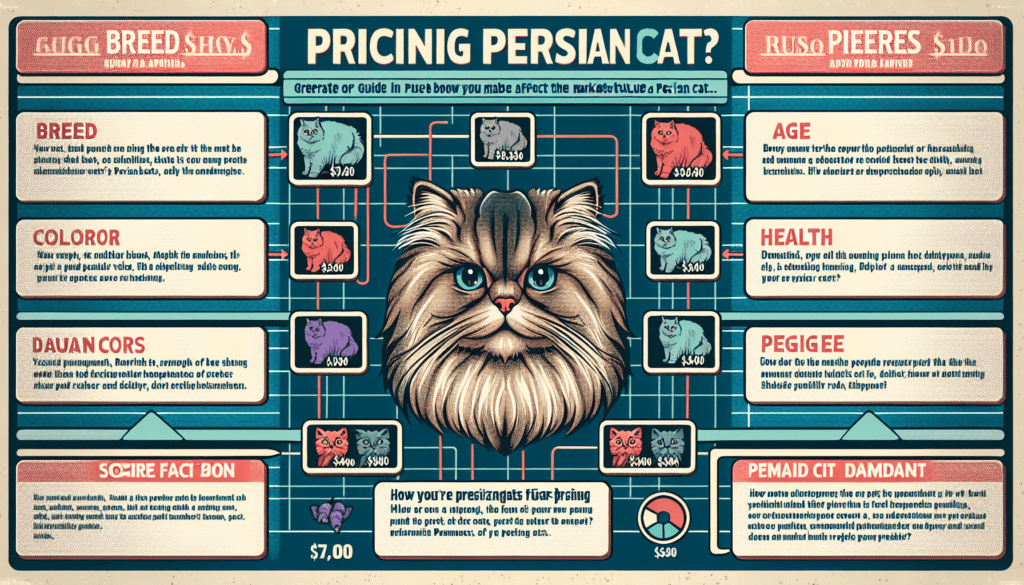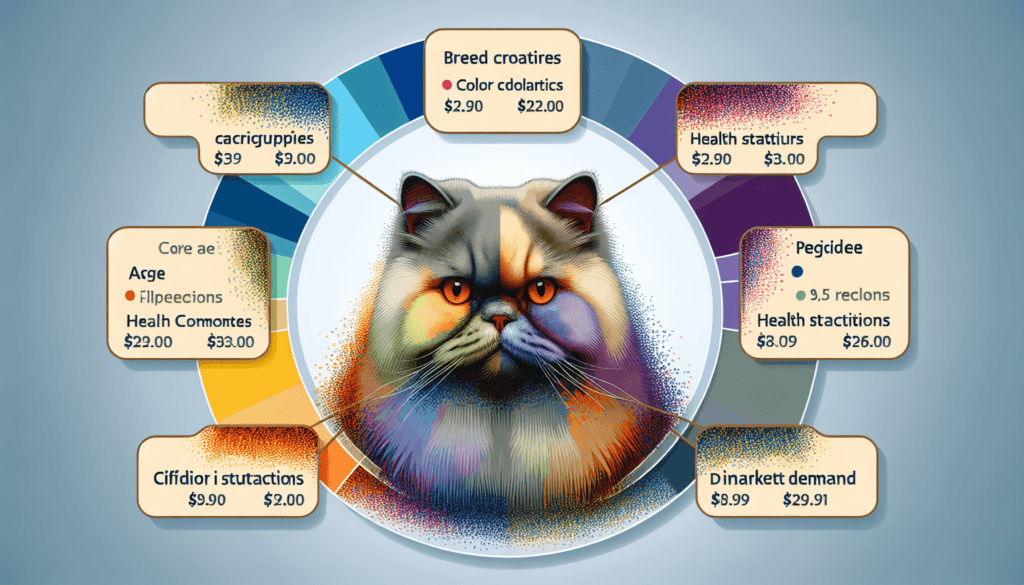Have you ever wondered how much a Persian cat costs? In this article, we will guide you through the process of determining the price of a Persian cat, considering various factors that affect its value. From the cat’s age and breed to its pedigree and physical characteristics, we will provide you with valuable insights to help you understand the pricing structure in the Persian cat market. Whether you are a prospective buyer or simply curious about the price range, by the end of this article, you will have a better understanding of how to determine the price of a Persian cat.
Factors that Affect the Price of a Persian Cat
Are you considering getting a Persian cat? These charming felines are known for their luxurious long coats and gentle temperaments. However, before bringing one of these fabulous furbabies into your home, it’s important to understand the various factors that can influence the price of a Persian cat. From breed quality and pedigree to physical characteristics and breeder reputation, there are several key considerations to keep in mind. So, let’s take a closer look at each of these factors and how they contribute to the overall cost of a Persian cat.
Breed Quality and Pedigree
When it comes to Persian cats, breed quality and pedigree play a significant role in determining their price. Purebred Persian cats, those who have parents of the same breed, are often more expensive than mixed breed Persians. Purebred cats have a more predictable appearance and temperament, making them highly sought after by enthusiasts and show cat lovers.
Additionally, registered Persian cats, those whose pedigrees are recognized by reputable cat registries such as The International Cat Association (TICA) or the Cat Fanciers’ Association (CFA), tend to have a higher price tag compared to non-registered Persians. Registration ensures the authenticity of the cat’s pedigree, providing documentation that proves their lineage.
For those looking for a top-tier Persian cat, the presence of a champion bloodline can further increase the price. These are cats whose ancestors have achieved prestigious titles and awards in cat shows, adding to their desirability.
Physical Characteristics
The physical characteristics of a Persian cat also influence its price. Various aspects, such as face structure, coat length, eye color and shape, and body size and proportions, contribute to the overall appeal and value of a Persian cat.
The face structure of a Persian cat can be categorized as either traditional or exotic. Traditional Persian cats have a more natural face shape, while exotic Persians have a more pronounced, “peke-face” appearance. Exotic Persians, with their unique features, tend to garner higher prices due to their distinctive looks.
Coat length is another crucial factor. Longhaired Persian cats, with their voluminous, flowing locks, are generally more expensive than shorthaired Persians. The mesmerizing beauty of a longhaired Persian cat’s coat requires extra grooming and care, which contributes to their elevated price.
Eye color and shape also come into play. Persian cats with rare eye colors, such as striking blue or odd-eyed (one eye blue, the other gold or green), are often priced higher due to their rarity. Additionally, cats with unique eye shapes, such as big, round eyes, are highly sought after by enthusiasts.
Lastly, body size and proportions can impact the price of a Persian cat. Persians with a well-balanced and proportionate body structure are typically more desirable and tend to command a higher price.


Gender
The gender of a Persian cat can influence its price as well. Male and female Persians often have different price ranges. Female Persian cats tend to be slightly more expensive than their male counterparts. However, the price may vary depending on factors such as availability and demand.
Another consideration is whether the cat is neutered/spayed or intact. Neutered or spayed Persians are generally priced lower than intact cats due to the decreased demand for breeding purposes and the associated responsibilities.
Age
Age is another key determinant of a Persian cat’s price. Persian cats can be categorized into three main age groups: kitten, adult, and senior.
Kittens, being the youngest and most sought after, often come at a higher price compared to adult or senior cats. The adorable and playful nature of kittens, combined with their longer lifespan, makes them a popular choice among cat lovers.
Adult Persian cats, typically between one to eight years old, are often priced at a more moderate range. They are already past their initial growth phase, making it easier for potential owners to determine their physical characteristics and temperament.
Senior Persian cats, usually over eight years old, may have a lower price tag due to their age. However, senior cats can make wonderful companions as they tend to be calmer and require less active playtime.


Health and Genetic Testing
The overall health condition of a Persian cat is an essential factor contributing to its price. Well-cared-for cats with no underlying health issues are generally priced higher than cats with known health conditions. Veterinary records and health certificates play a crucial role in assessing a Persian cat’s health status and can affect its market value.
In addition to general health, genetic testing is an important consideration for Persian cat prices. Persian cats bred from parents who have undergone genetic testing for common breed-related health issues, such as polycystic kidney disease (PKD) or hypertrophic cardiomyopathy (HCM), tend to have a higher price. These tests ensure that the cat is less prone to hereditary diseases and gives potential owners peace of mind.
Breeder Reputation
The reputation of the breeder also influences the price of a Persian cat. Established breeders with a long-standing reputation for producing healthy and well-socialized kittens often charge higher fees. They invest time, effort, and resources into breeding programs that prioritize the cat’s overall well-being.
Hobby breeders, on the other hand, may offer lower prices due to various factors, such as breeding as a hobby or having a smaller-scale operation. While hobby breeders can produce healthy and happy Persian cats, it’s essential to do thorough research and ensure their breeding practices align with responsible breeding guidelines.
Customer satisfaction and recommendations from previous buyers can be a valuable indicator of a breeder’s reputation. Positive reviews and testimonials can give you confidence in choosing a breeder and may justify a higher price.
Geographical Location
The geographical location where a Persian cat is bred or purchased can impact its price. Prices may vary between regions or countries depending on factors such as supply and demand, cost of living, and local breeder competition.
Additionally, if you are considering purchasing a Persian cat from a breeder located far from your home, you will need to consider shipping and transportation costs. These additional expenses can significantly affect the total price of the cat.
Color and Coat Pattern
The color and coat pattern of a Persian cat can also affect its price. Persian cats come in a wide variety of colors and patterns, each with its own unique appeal.
Solid colors, such as white, black, or blue, are often more readily available and may have a lower price compared to rarer color variations. Bi-color and parti-color Persians, with their striking combinations of color, tend to be more sought after and can command a higher price.
Tabby patterns, known for their distinctive stripes or swirls, can also influence a Persian cat’s price. Certain tabby patterns, such as classic or mackerel, may be more desired and, therefore, priced higher.
Shaded and smoke coat patterns, with their mysterious and ethereal appearance, often come at a premium price due to the time-consuming grooming and care they require.
Lastly, point colors, which feature darker coloration on the extremities (face, ears, paws, and tail), are highly popular and may have a higher price due to their striking contrast.
Availability and Demand
The availability of Persian cats and the level of demand in your area or within the breeder community can also impact their price. If Persian cats are scarce or in high demand, the price is likely to be higher. Conversely, if there is an abundance of Persian cats available, the price may be more competitive.
Factors such as trendy color variations, specific coat patterns, or popular celebrity endorsements can create a surge in demand for certain types of Persian cats, ultimately affecting their price.
Accompanying Accessories and Services
When purchasing a Persian cat, it’s essential to consider the additional accessories and services that may come with the cat. While these may not directly affect the cat’s price, they can add value to your overall purchase.
Pedigree papers and registration documents help ensure the authenticity and provenance of your Persian cat. These documents serve as proof of the cat’s lineage and are often provided by reputable breeders at an additional cost.
A health guarantee is another valuable inclusion. Reputable breeders typically offer a warranty against certain health conditions, giving you peace of mind and financial protection should any unexpected health issues arise.
Microchipping is a common practice in the cat breeding community. This procedure involves implanting a tiny identification chip under the cat’s skin, which can be scanned to retrieve your contact information if the cat gets lost.
Vet check-ups and vaccinations are essential for maintaining the health and well-being of your Persian cat. Some breeders may include these services in the initial price, while others may charge them separately.
Starter kits, which may include food samples, toys, bedding, or other essentials, can be a convenient way to kick-start your life with your new Persian companion. While these kits may incur an additional cost, they can save you time and effort in preparing for your cat’s arrival.
Grooming tools and supplies are crucial for maintaining the beauty and health of your Persian cat’s luxurious coat. Certain breeders may offer recommendations or even provide a grooming kit to ensure you have everything needed to keep your cat looking its best.
In conclusion, determining the price of a Persian cat involves considering multiple factors. Breed quality and pedigree, physical characteristics, gender, age, health and genetic testing, breeder reputation, geographical location, color and coat pattern, availability and demand, and accompanying accessories and services all contribute to the overall price range. By understanding these factors, you can make an informed decision and find the perfect Persian cat to join your family. So go ahead and start your journey to finding your very own majestic, fluffy friend!

